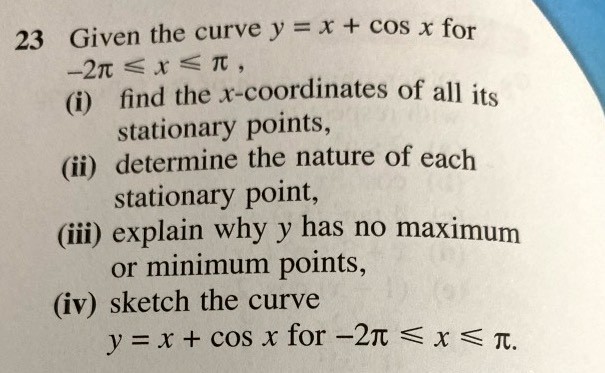Ask Singapore Homework?
Upload a photo of a Singapore homework and someone will email you the solution for free.

Question
secondary 4 | A Maths
One Answer Below
This question need another answer.

only need q23(iii) explain q part thankyouu
Of course, out of this, we know that sin x goes from -1 to 1.
So, 1 - sin x cannot possibly go below 0 (since sin x is at most 1).
Means, dy/dx >= 0 all the time.
So, surrounding the dy/dx = 0 point, the gradients are all positive.
So, the stationary points must be points of inflection and cannot be a maximum or a minimum.
(i.e gradient will be positive immediately right after and before this point, or negative right after and before this point)
In this case we only see positive gradients for the points that are not inflection points.
For a minimum point, it is the opposite.
In both cases there will be a sign change. In your answer you should mention the lack of sign change for those inflection points.
(Edited)
Second derivative test :
Because d²y/dx² is the rate of change of the gradient , dy/dx
If d²y/dx² > 0, it means the gradient here is strictly increasing as x increases. This is why we say it's a minimum point as the gradient changes from negative before it to positive after it (thereby strictly increasing across the point)
Similarly,
If d²y/dx² < 0, it means the gradient is strictly decreasing here as x increases. This is why we say it's a maximum point as the gradient changes from positive before it to negative after it (thereby strictly decreasing across the point)
When d²y/dx² = 0, it is inconclusive. We can go back to the first derivative test, or check the concavity of the point (mentioned in a later comment)
I’m quite curious because wouldn’t/shouldn’t it then be enough to explain that all points are inflexion and hence not max/min in part (III)?
It’s like saying, a soccer ball went out of the playing field...
...because the ball did not enter the goal post, even though it is true that missing the goal post would mean the ball went out (assuming the ball does not rebound).
P.S.
When I looked at this question initially, I took it that part iii was asking for the entire unlimited curve y (not just for the region -2pi to pi), so I could not simply conclude that all other stationary points must be a non maxima and a non minima.
But not all the time d2y/dx2 = 0 leads to points of inflection.
(yes, I have no idea how to type a power of 2 or 3 from my phone)
Take y = x^4 for example, with dy/dx = 4x^3 and d2y/dx2 = 12x^2. Its only stationary point, (0, 0) will have a d2y/dx2 value of 0.
Yet the point is a minimum point and not a point of inflection, which is why when d2y/dx2 = 0, the result is inconclusive and we will have to rely back on the first derivative test to make the conclusion.
(Skaze)
Also, do take note that the values of d2y/dx2 have little meaning to us if the relevant point is not even a stationary point. So if d2y/dx2 = 5 (but the corresponding value of dy/dx is say 3), the point is not a minimum point at all.
But I wouldn't say that the value of d²y/dx² has little meaning if the point is not a stationary point. It is still used to check for concavity and applied in finding an inflection point.
so dy/dx = 0 and d²y/dx² = 0
If d²y/dx² does not change sign, the concavity is the same.
d²y/dx² > 0 on both sides means it would be concave upward on both sides and thus the stationary point is a minimum.
d²y/dx² < 0 on both sides means it would be concave downward on both sides and thus the stationary point is a maximum.
But if it changes sign, then this stationary point would be an inflection point as well.
However, having d²y/dx² = 0 does not guarantee that a point is an inflection point.
See 1 Answer





